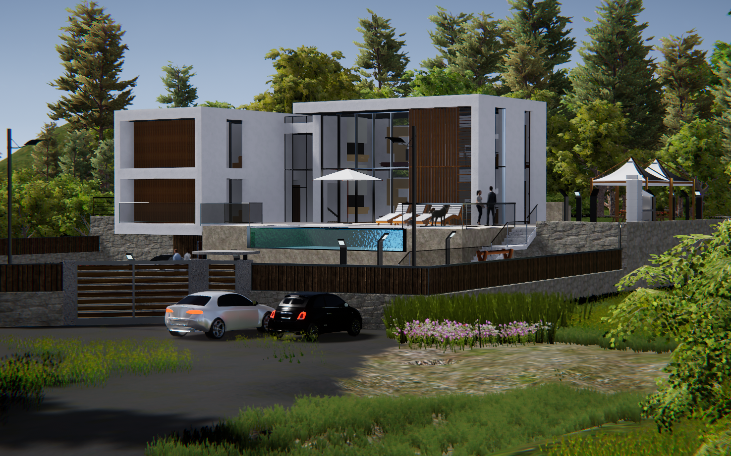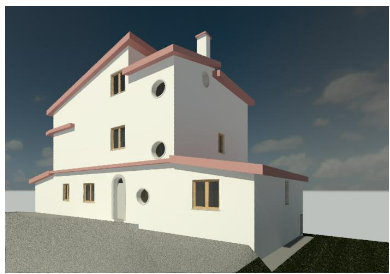AUTHOR: Dott. Ing. Daniele Squillace
TUTORS: Prof. Ing. Alessandro Zichi
INTERNSHIP: —
MASTER: Master in “Sustainability and energy management in construction works” a.a 2020/21
La normativa internazionale, e di conseguenza quella Italiana, negl’ultimi anni ha dato un’enorme spinta al comparto dell’edilizia, allo scopo di riqualificare il patrimonio immobiliare esistente e realizzare nuovi edifici che abbiano un impatto quasi zero dal punto
di vista energetico, da qui la definizione di nZEB.
Con il decreto “Rilancio”, il Governo italiano, ha instituito una nuova misura di incentivazione fiscale, il cosidetto “Superbonus 110%”. Tale misura prevede la possibilità di effettuare lavori di efficientamento energetico, a costo zero per i cittadini.
Si è realizzata la progettazione di un intervento di demolizione e ricostruzione, di un fabbricato su 3 livelli F.T., risalente agli anni ’70, con una classe energetica di partenza molto bassa.
Sfruttando il BIM, Building Information Model, si è riuscita ad integrare la modellazione dell’edificio esistente, e di quello che lo sostituirà, con la modellazione energetica dello stesso, ottenendo il cosidetto BEM, Building Energy Model.
Effettuando simulazioni sul modello virtuale, è possibile prevedere la risposta del modello reale, e ciò comporta un enorme vantaggio, sia in termini di tempo, sia in termini di costi.
Anche la fase manutentiva trae notevoli benefici, in quanto valutare gli effetti dei possibili interventi sul modello virtuale consente di definire in maniera assolutamente oggettiva quale sarà l’intervento migliore da attuare.
Da qui il concetto di Digital Twin, il “gemello digitale”, un modello virtuale di un oggetto reale, sul quale fare test e valutazioni in modo da evitare potenziali problemi e/o errori che potrebbero generare grosse diseconomie, sia dal punto di vista finanziario, che dal punto di vista tecnico e di tempistiche.
Partendo da una nuvola di punti, si è così realizzato il modello dello Stato di fatto dell’edificio, tramite l’ausilio del software AUTODESK REVIT.
In seguito, le informazioni di tale modello sono state trasferite sul software BLUMATICA BIM, dove si è proceduto alla realizzazione del BEM. Sono stati inseriti, oltre ai dati geometrici dell’edificio, tutte le informazioni energetiche, come ad esempio la presenza di impianti, la tipologia di isolamento, le caratteristiche dell’involucro opaco e delle strutture trasparenti, i dati climatici di zona.
Da tali operazioni, si è constatato che l’edificio esistente ha un comportamento negativo dal punto di vista energetico, tanto da farlo ricadere in una classe energetica molto bassa.
Si è proceduto alla progettazione del nuovo edificio; come richiesto dalle normative, sia le strutture opache verticali e orizzontali che le strutture trasparenti, sono state concepite rispettando i termini di trasmittanza previsti dai decreti.
Dal punto di vista impiantistico, sono state ipotizzate due soluzioni, entrambe molto valide dal punto di vista energetico.
La prima, prevede dei sistemi trivalenti a pompa di calore, per la produzione di ACS e per i servizi di riscaldamento/raffrescamento, con l’integrazione di impianti fotovoltaici per la copertura di energia elettrica da fonti rinnovabili.
La seconda, invece, prevede che i servizi siano splittati. Delle pompe di calore con accumulo, collegate a degli impianti solari termici posti sul tetto a falde, per la produzione di ACS; dei sistemi VRF per i servizi di riscaldamento/raffrescamento, collegati a impianti fotovoltaici.
Entrambe le soluzioni, fanno rientrare l’edificio nella categoria nZEB, e sta al committente la scelta che più lo soddisfa dal punto di vista dell’utilizzatore finale. Il progettista ha il compito di studiare più soluzioni possibili, che portino sempre allo stesso risultato desiderato e richiesto dalla normativa vigente.
Il risultato finale, porta ad una copertura da fonti rinnovabili che super il 90%, e si è riusciti ad eliminare l’utilizzo di combustibili fossili.
FOR INTERNATIONAL STUDENTS:
International legislation, and consequently the Italian one, has given in the last few years a huge boost to the construction sector, in order to redevelop the assets existing real estate and build new buildings that have almost zero impact about the energy point of view, hence the definition of nZEB.
With the “Relaunch” decree, the Italian government instituted a new incentive measure tax, the so-called “Superbonus 110%”. This measure provides for the possibility of carrying out works of energy efficiency, at no cost to citizens.
With the AEC Company, the design of a demolition project was carried out and reconstruction, of a building on 3 F.T. levels, dating back to the 70s, with a low energy class departure.
By exploiting the BIM, Building Information Model, it was possible to integrate the modeling of the existing building with the energy modeling of the itself, obtaining the so-called BEM, Building Energy Model.
By performing simulations on the virtual model, it is possible to predict the response of the model real, and this entails an enormous advantage, both in terms of time and in terms of costs.
The maintenance phase also draws significant benefits, as it assesses the effects of the possible ones interventions on the virtual model allows to define in an absolutely objective way what will be the best intervention to implement.
Hence the concept of the Digital Twin, a virtual model of an object real, on which to make tests and evaluations in order to avoid potential problems and / or errors that they could generate big diseconomies, both from the financial point of view and from the point of technical and timing view.
Starting from a cloud of points, the model of the current state of the building was created, using the AUTODESK REVIT software.
After that, the information of this model was transferred to the BLUMATICA BIM software, where the BEM was implemented. They have been entered, in addition to the data geometric elements of the building, all energy information, such as the presence of systems, the type of insulation, the characteristics of the opaque envelope and transparent structures, the climatic data of the area.
From these operations, it was found that the existing building has had a negative behavior since energy point of view. I proceeded to model the new building. As required by the regulations, both vertical and horizontal opaque structures and transparent structures, have been conceived respecting the transmission deadlines provided for by the decrees.
From the plant engineering point of view, two solutions have been hypothesized, both of which are very valid
from an energy point of view.
The first involves trivalent heat pump systems, for the production of ACS and for the heating / cooling services, with the integration of photovoltaic systems for the coverage of electricity from renewable sources.
The second, provides that the services are split. Heat pumps with storage, connected to solar thermal systems placed on the pitched roof, for the production of ACS and the VRF systems for heating / cooling services, connected to photovoltaic systems.
Both solutions make the building fall into the NZEB category, and it is up to the client choice that most satisfies him from the point of view of the end user. The designer has the task to study as many solutions as possible, which always lead to the same desired result e required by current legislation.
The final result leads to a coverage from renewable sources that exceeds 90%, and it has been possible to achieve eliminate the use of fossil fuels.


